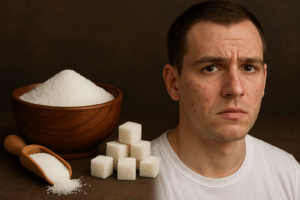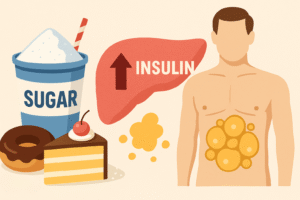Ever wonder why you’re always tired, bloated, moody, or craving something sweet—again? Yeah. You might be eating too much sugar without even realizing it. Not just candy or soda… but the sneaky sugar hiding in your “healthy” cereal, salad dressing, and even that low-fat yogurt you thought was helping.
So let’s break this sugar trap wide open. You’ll learn how sugar affects your body, how to spot sugar addiction, how many grams of sugar a day you should be having, and yes—how the heck to finally stop sugar cravings before they stop you.
What Counts as Sugar?
You’re probably thinking, “I don’t even eat sweets that much.” But sugar ain’t just in cupcakes and candy bars.
Here’s where it hides:
-
Added sugar – table sugar, syrups, dextrose, fructose, etc.
-
Natural sugar – in fruits, veggies, dairy. (Still counts, kind of.)
-
Hidden sugar – in sauces, bread, flavored yogurts, soups, and salads?! Yep.
Common sugar aliases you’ll see on labels:
| Name on Label | Still Sugar? |
|---|---|
| High-fructose corn syrup | YES |
| Cane juice | YES |
| Agave nectar | YES |
| Maltose | YES |
| Evaporated cane syrup | YES |
| Fruit concentrate | YEP |
If it ends in “-ose”, it’s probably sugar wearing a fake mustache.
How Much Sugar Is Too Much?
So how many grams of sugar per day should you be having?
According to the American Heart Association:
-
Men: Max of 36 grams (that’s 9 teaspoons)
-
Women: Max of 25 grams (about 6 teaspoons)
-
Kids: Even less
Now check this out:
| Food Item | Sugar (grams) | Teaspoons |
|---|---|---|
| 1 can of soda | 39g | 9.75 tsp |
| Flavored yogurt (1 cup) | 18g | 4.5 tsp |
| Granola bar | 12g | 3 tsp |
| Ketchup (2 tbsp) | 8g | 2 tsp |
| “Healthy” smoothie bottle | 45g | 11 tsp |
One drink can max out your entire day’s sugar allowance. Insane, right?
“Most people are eating 2–3x the recommended amount. Daily.” — CDC, 2024
How Sugar Affects Your Body
You don’t need a medical degree to feel what sugar does. You know the highs and crashes. But let’s dig a lil’ deeper:
1. Your Brain
-
Gives you a dopamine rush like a drug (literally)
-
Makes you feel good for a sec… then you crash
-
Builds cravings just like nicotine or alcohol

2. Your Skin
-
Acne flares
-
Skin starts looking dull or puffy
-
Accelerates aging and wrinkles (yikes)
3. Your Belly
-
Spikes insulin, stores fat
-
Can lead to belly fat and bloating
-
Increases risk of Type 2 diabetes

4. Your Mood
-
Makes you anxious, tired, cranky
-
Messes with sleep and hormones
-
Can even trigger depression symptoms
“A 2023 Harvard study found people who consumed high sugar diets were 23% more likely to report depressive moods.”
Source: Harvard Health Publishing
The Sneaky Signs of Sugar Addiction
You might not think you’re addicted. But read this list and tell me you don’t relate to at least 3…
-
You crave something sweet after every meal
-
You feel “hangry” if you don’t eat carbs
-
You start the day with cereal or bread
-
You reward yourself with a dessert (daily)
-
You try to stop sugar, but always cave
If that’s you… it’s not just a sweet tooth. It’s a cycle.
How to Stop Sugar Cravings (Without Losing Your Mind)
Kicking sugar is tough. Your brain will legit throw a tantrum. But you can break the loop.
Here’s how:
1. Eat More Protein + Fat
Keeps blood sugar stable, reduces hunger.
-
Eggs, chicken, tofu, almonds
2. Don’t Skip Meals
Skipping makes cravings worse later. Trust.
3. Stay Hydrated
Dehydration feels like hunger.
-
Drink a glass of water first before snacking
4. Sleep Enough
Less sleep = more cravings. Period.
5. Watch Out for “Healthy” Junk
Granola, smoothies, protein bars. Read labels!
6. Go Cold Turkey (for 7 Days)
Rough at first, but cravings drop fast after the first week.

What Happens When You Quit Sugar?
In case you need motivation… here’s what happens when you finally stop shoveling sugar into your body.
| Timeline | What You Feel |
|---|---|
| Day 1–3 | Headaches, mood swings, fatigue (hang in) |
| Day 4–7 | Fewer cravings, clearer thinking |
| Week 2 | More energy, better sleep, less bloat |
| Week 3+ | Weight loss, clear skin, improved mood |
Your body literally heals from the inside out.
Real Talk: Is All Sugar Bad?
Nope. Your body needs some sugar to function. Especially from:
-
Fruits
-
Vegetables
-
Whole grains
But it’s the added sugar in processed food that wrecks you.
Think:
-
Candy bars
-
Sweetened coffee
-
Store-bought sauces
-
Baked goods
These spike your insulin, trigger cravings, and give you zero nutritional value.

Smart Sugar Swaps That Actually Work
Want to cut sugar without feeling deprived? Try these:
| Sugar Fix Craving | Swap It With… |
|---|---|
| Soda | Sparkling water + lemon/lime |
| Ice cream | Greek yogurt + berries |
| Candy | Frozen grapes or mango |
| Sugary cereal | Oats + banana + cinnamon |
| Chocolate | Dark chocolate (70%+ cacao) |
Little swaps = big wins.
FAQs: Too Much Sugar
Q: How many grams of sugar in a teaspoon?
A: About 4 grams. So 20 grams of sugar = 5 teaspoons.
Q: Can I eat fruit if I’m cutting sugar?
A: Yes! Natural sugar in fruit comes with fiber and nutrients. Just don’t go overboard with fruit juices or dried fruits.
Q: What’s the #1 hidden sugar food?
A: Drinks. Soda, sports drinks, “healthy” smoothies, sweetened coffee.
Q: How long does it take to stop sugar cravings?
A: Usually around 7 to 14 days. Cravings decrease dramatically if you don’t give in.
Q: Is sugar really addictive?
A: Yep. Brain imaging shows sugar lights up your brain the same way as cocaine and nicotine.
Final Thoughts: Sugar Ain’t Just a Sweet Treat… It’s a Sneaky Health Wrecker
Here’s the deal. Sugar’s not evil, but the amount you’re probably eating every day is messing you up in ways you didn’t even realize.
But now you do. And you can actually do something about it.
Start small. Cut the soda. Switch the cereal. Eat real food. Keep showing up for your body—and your body will show up for you.
Sources
-
American Heart Association – “Sugar 101”
https://www.heart.org/en/healthy-living/healthy-eating/eat-smart/sugar -
Harvard Health Publishing – “The sweet danger of sugar” (2024)
https://www.health.harvard.edu/blog/the-sweet-danger-of-sugar-201601019068 -
CDC – “Added sugars and health” (2023)
https://www.cdc.gov/nutrition/data-statistics/added-sugars.html
